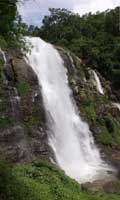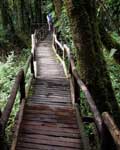 |
| 1. Nam Tok Watchirathan
|
|
 |
 |
| 2. Karen village
|
|
 |
 |
| 3. Back-strap loom
|
|
 |
 |
| 4. Royal Project flower
|
|
 |
 |
| 5. The Queen's chedi
|
|
 |
 |
| 6. Aang Ka trail
|
|
|
 |
|
 |
At 2,565 meters (8,400 feet), Doi Inthanon (Inthanon Mountain) is the highest peak in Thailand. The entire mountain is included in the 482 square kilometer Doi Inthanon National Park. We visited the Park in the middle of July during the rainy season. We had light clouds for most of the day, cool temperatures, and mist near the summit.
Our first stop was at Nam Tok Watchirathan, one of the 2 or 3 most impressive of the mountain's many waterfalls (see photo #1, at left). It is really quite stunning. The water falls from a sufficient height that it breaks up at the bottom into a fine mist and generates a wind that carries the mist for some distance away from the waterfall. Everything near the falls is wet, and one must take care while walking on the slippery stones. Watchirathan waterfall was a wonderful beginning for our visit to Doi Inthanon.
There are perhaps 4,000 Hmong and Karen tribespeople living in Doi Inthanon National Park. We visited a small white-Karen village (photo #2) during our trip up the mountain. (These people call themselves white-Karen because the young girls wear traditional white clothing until they are married.) At the time of our visit, there were only a few people in the village. The others were in the surrounding forest tending their coffee plants. Arabica coffee has been introduced from Brazil in an effort to diversify the economy of the hill-tribes. Coffee can be grown on mountain slopes, and will thrive in the shade of the existing trees. This means that the hillsides can be planted with coffee without cutting down the existing trees and causing erosion.
The women of the village are also working to produce decorative cotton textiles. They sit on the floor using a back-strap loom (photo #3) to weave beautiful patterns into the fabrics that they produce. By leaning against the back strap, they control the tension on the threads. The resulting textiles are sold to the tourists who visit the village.
The Inthanon Royal Project Research Station is one of many projects undertaken by the King to improve the lives of the hill tribes. This Project has focused on using green houses to produce fruits, vegetables, and flowers (photo #4) on the slopes of Doi Inthanon. These products are then sold in markets throughout Thailand. We toured some of the greenhouses where they are raising flowers and cacti, and were impressed by the beauty, and high quality, of the many plants that we saw. Everything was neat and well maintained, and the plants were all healthy. The Project's greenhouses have been joined by large numbers of greenhouses built by the Karen and Hmong people who have learned horticultural skills from the Project. They can sell their products themselves, or through a cooperative arrangement with the Project.
Near the top of the mountain are two stupas (or chedis) built in honor of the current King and Queen of Thailand (photo #5). On the day of our visit, Doi Inthanon was shrouded in the clouds that often cover it's peak. The mists would come and go, swirling around the two pagodas so that they would appear clearly for a moment and then all but disappear into the fog. And then, the clouds would part and clear blue sky and bright sunlight would warm us for a moment. Then the grey-white mists would return. The mists and fog added an air of mystery to the impressive grandeur of the two pagodas.
Very near the to the highest point on the mountain is the Aang Ka nature trail. Only about 180 meters long, this circular path through the forest was the highlight of our trip. Nearly the entire length of the trail consists of a series of raised, wooden walkways (photo #6) that carried us above the wet, boggy soil beneath. The trees are covered with mosses and lichen; there are ferns growing everywhere, and the trees echo with the calls of hidden birds. Under the trees and the mountain mists, the forest is bathed in a green twilight that gave the entire experience a truly magical quality. Just those few minutes we spent in the forest would have made the whole trip worthwhile. We were surprised to find that most of the other visitors to the mountain went right past the Aang Ka trail without even stopping. We think that they missed the best part of the Doi Inthanon experience.
And then, just as we were leaving the mountain top, it began to rain. Our timing was perfect, and we began our return trip to Chiang Mai after a really great day on Inthanon Mountain. Here are some additional photos from our trip:
| NOTE: Jim sold an extended version of this story, and many of the accompanying photos, to a glossy English-language travel magazine called Chiang Mai Nopburee. The story is scheduled to appear later this year.
|
— return to the 2004 Journal Archive
|